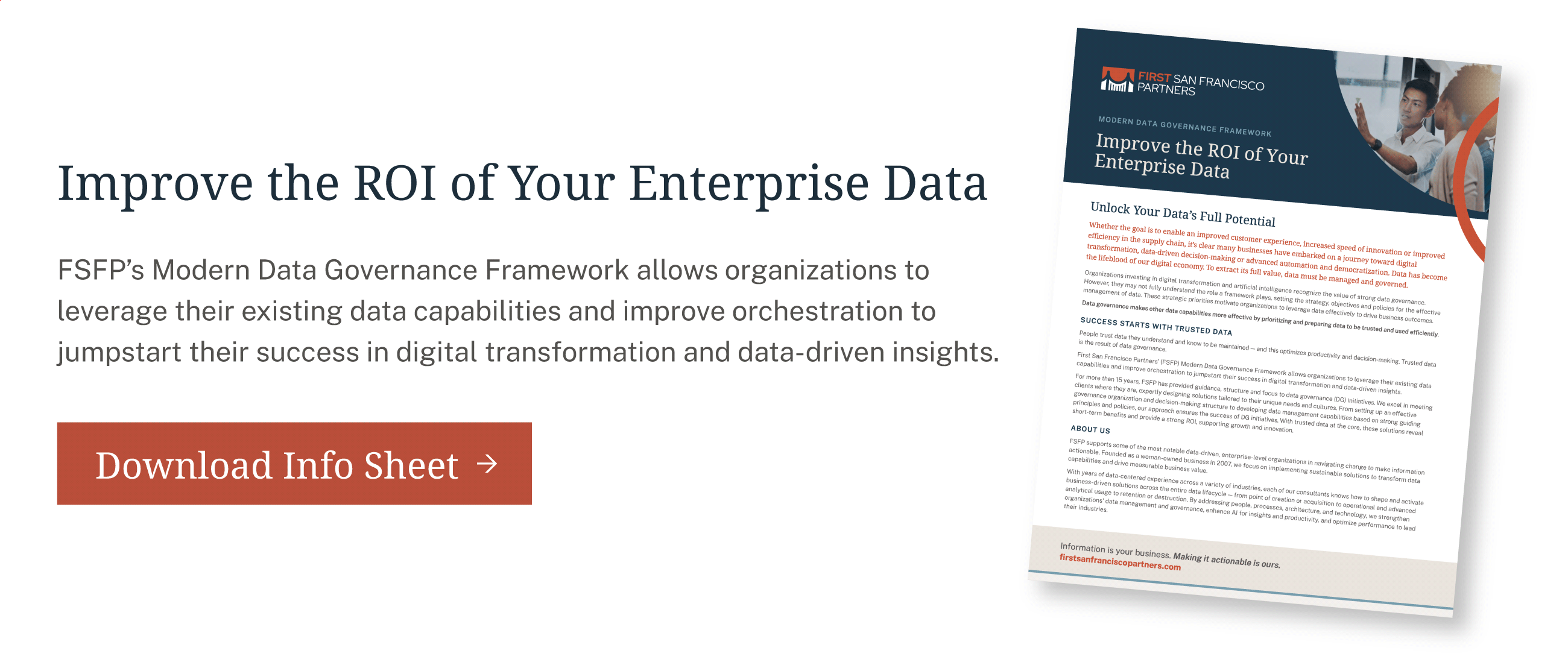It’s no secret cloud services are revolutionizing the world of business. According to Flexera, 94% of enterprises already use a cloud service. This year alone, the public cloud infrastructure market was expected to grow by 35% according to Forrester. Cloud adoption has become a matter of when — not if — for many digital and data-driven organizations.
Whether you’re considering migrating to the cloud or you’re already there, here are data governance and data management best practices and key considerations to keep in mind.
Understand the Challenges and Opportunities
Cloud adoption is widespread for its many benefits, including enhanced security, low cost storage, increased flexibility and improved analytics. But it isn’t without its unique challenges, including the:
- Greater likelihood of high volume, variety, velocity, veracity and value
- Increased use of external data
- Complexity of data management in the cloud
- Conflicting priorities for cloud usage and what needs to be governed to ensure compliance and effective use
- Overlap of services and lack of compatibility between different vendors
It’s important to consider these challenges to determine cloud-readiness and ongoing business value. Planning for these potential issues — and proactively mitigating them — can save your organization both time and money.
Underpin Cloud Adoption with Governance
Many organizations believe data in the cloud should be highly aligned and loosely coupled, but this doesn’t mean governance isn’t needed. In fact, the opposite is true. Cloud data governance provides a set of organizational structures, policies and processes for the management of data-related activities in the cloud ecosystem.
As with any other technology implementation, it is important to first understand the data needs of, and for, those solutions. Any gaps between what is provided and what is expected can then be identified, quantified, managed and measured. This helps mitigate operational and financial loss due to inefficiency and misalignment with key business objectives.
Without sound governance practices in place, the perceived benefits of cloud adoption can sometimes lead to costly misconceptions.
Since cloud technologies make it possible to quickly spin up and test new tool environments, some organizations may think cloud adoption results in little to no technical debt. But what a hasty cloud implementation lacks in technical debt risk, it makes up for in potential tool proliferation when multiple and redundant cloud environments are rarely shut down. A robust cloud data governance strategy, with data understanding, can ensure accountability for data in every cloud solution – which hopefully will translate to accountability for the solution itself.
It is important to truly plan for and embed governance best practices before, during and after cloud adoption (and ongoing maintenance). Keep these key questions top of mind:
- Do you know what data is in the cloud?
- Who put it there?
- Should it be there?
- How is it being protected?
- Who is accountable to maintain it?
Streamline Multi-Cloud Governance
Data integration between multiple cloud-based applications can be even more complex. While there may be a clear value proposition for storing data in the cloud (due to volume) and using cloud-based applications, when it comes to metadata, it may be more difficult because you have to understand the metadata of both on-premise and cloud solutions.
One best practice is to centralize and automate control by creating scalable global policies and access controls that can be implemented however necessary, across both on-premise and cloud-based solutions, to avoid confusion or miscommunication. For added efficiency, consider leveraging a metadata tool to create that understanding, integrate technical and business metadata and promote on-going management and maintenance of the content.
Understand Cloud Vendors’ Governance and Microservices
Before choosing a cloud vendor, make sure you verify the cloud vendor’s governance approach. In some cases, their security and privacy standards may be higher than what you can accomplish in-house. Top cloud vendors understand the importance of data governance (and supporting their customers’ existing data governance practice) and will offer tools for metadata cataloging, access control and management, data quality, data assessment and data security as core capabilities.
Because much of the cloud is “microservices” or services that do a specific task, vendor management can be a challenging part of cloud governance. More often than not, a specific cloud vendor specializes in these tasks. It is not unusual for organizations to have multiple cloud vendors for different services, making governance even more critical.
Determine Data Needs
Many organizations have embraced a cloud-first strategy. If this is your approach, take advantage of the opportunity cloud creates to shift to a data-centric perspective that improves data understanding and governance. Doing so can shed key insights on your organization’s data-driven needs and enable you to develop scalable policies in direct alignment.
Another critical area to consider when migrating to the cloud is metadata management. Metadata plays a significant role in optimizing your cloud environment. Having the capabilities to capture, maintain and most importantly, understand, metadata is critical. Cloud data governance coupled with metadata management can be foundational for ensuring you are automating access and usage appropriately.
Taking a data-centric approach to the development strategy also means understanding your data and information requirements, along with functional and technical requirements. These requirements will inform your metadata, data structuring and data quality needs from the cloud vendor. The right vendor partner can help you meet these requirements.
Gartner estimates worldwide end-user spending on public cloud services will exceed $300 billion in 2021. To ensure a sustainable, compliant, scalable and cost-effective cloud approach that provides lasting business value, data governance needs to be part of every cloud journey.



